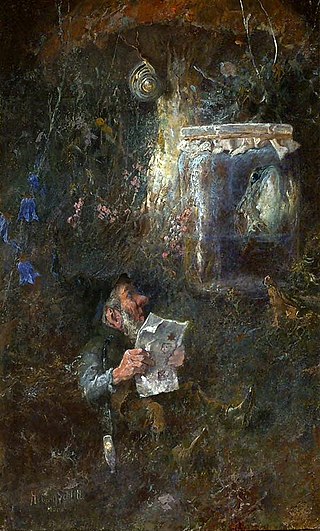
A gnome is a mythological creature and diminutive spirit in Renaissance magic and alchemy, introduced by Paracelsus in the 16th century and widely adopted by authors including those of modern fantasy literature. Typically small humanoids who live underground, gnome characteristics are reinterpreted to suit various storytellers and artists.

Glorantha is a fantasy world created by Greg Stafford.
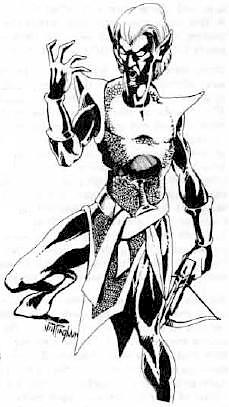
The drow or dark elves are a dark-skinned and white-haired subrace of elves connected to the subterranean Underdark in the Dungeons & Dragons fantasy roleplaying game. The drow have traditionally been portrayed as generally evil and connected to the evil spider goddess Lolth. However, later editions of Dungeons & Dragons have moved away from this portrayal and preassigned alignment. More recent publications have explored drow societies unconnected to Lolth.

Dragonlance Adventures is a 128-page hardcover book for the Dragonlance campaign setting for the first edition of the Advanced Dungeons & Dragons fantasy role-playing game.
Birthright is a Dungeons & Dragons campaign setting that was first released by TSR in 1995. It is based on the continent of Cerilia on the world of Aebrynis, in which the players take on the role of the divinely-empowered rulers, with emphasis on the political rulership level of gameplay. The setting revolves around the concept of bloodlines: divine power gained by heroes and passed on to their descendants. Characters with a bloodline create an aura of command known as Regency, which is measured in the game using regency points or RP. Using regency, characters acquire a domain composed of provinces and holdings. The development of these domains is as much a part of the game as development of the characters. The game uses three-month domain turns to model actions of rulers over nations in much the same way as Dungeons & Dragons uses combat rounds to simulate time to model the characters' actions in battle. In 1996, Birthright won the Origins Award for Best Roleplaying Supplement of 1995.
Al-Qadim is a campaign setting for the Dungeons & Dragons role-playing game which was developed by Jeff Grubb with Andria Hayday for TSR, Inc., and was first released in 1992. Al-Qadim uses One Thousand and One Nights as a theme and is set in the land of Zakhara, called the Land of Fate. Thematically, the land of Zakhara is a blend of the historical Muslim Caliphates, the stories of legend, and a wealth of Hollywood cinematic history. Zakhara is a peninsula on the continent of Faerûn in the world of Toril, the locale of the Forgotten Realms campaign setting, although Al-Qadim is designed to stand on its own or be added to any existing campaign setting. The basic campaign setting was divided between two game products: Al-Qadim: Arabian Adventures, a sourcebook describing character creation rules, equipment, and spells unique to the setting, and Al-Qadim: Land of Fate, a boxed set describing the land of Zakhara, with separate sourcebooks for the players and the Dungeon Master.
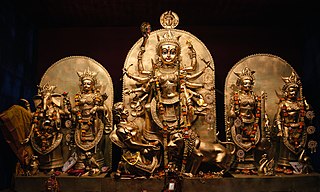
A pantheon is the particular set of all gods of any individual polytheistic religion, mythology, or tradition.
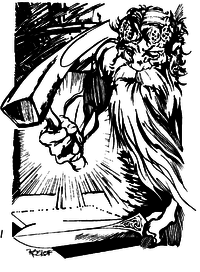
Moradin is the chief deity in the dwarven pantheon in the Dungeons & Dragons game and is a member of the default D&D pantheon. In 3rd edition, Moradin's domains are Creation, Earth, Good, Law, and Protection. The 5th Edition Players Handbook include Knowledge as a suggested domain. His titles include Soul Forger, Dwarffather, the All-Father, and the Creator. He created the first dwarves out of earthen materials and tutored them in dwarven ways.
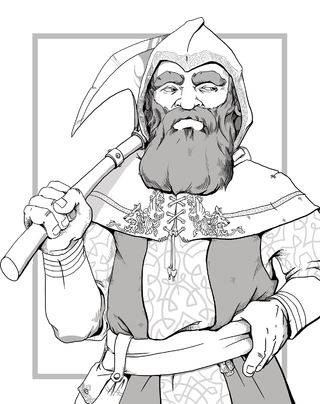
A dwarf, in the Dungeons & Dragons (D&D) fantasy roleplaying game, is a humanoid race, one of the primary races available for player characters. The idea for the D&D dwarf comes from the dwarves of European mythologies and J. R. R. Tolkien's novel The Lord of the Rings (1954-1955), and has been used in D&D and its predecessor Chainmail since the early 1970s. Variations from the standard dwarf archetype of a short and stout demihuman are commonly called subraces, of which there are more than a dozen across many different rule sets and campaign settings.
In the Dungeons & Dragons fantasy roleplaying game, Tharizdun is the god of Eternal Darkness, Decay, Entropy, Malign Knowledge, Insanity, and Cold. He originated in the World of Greyhawk campaign setting but has since also appeared in other settings.

In the Dungeons & Dragons (D&D) role-playing game, Bahamut is a powerful draconic deity, who has the same name as Bahamut from Arabic mythology.
Midnight is a campaign setting for the Dungeons & Dragons role-playing game, released under the Open Gaming License. It was published by Fantasy Flight Games from 2003 to 2009.
The Sovereign Stone series is a trilogy of fantasy novels: Well of Darkness (2000), Guardians of the Lost (2001), and Journey into the Void (2003), set in the same universe of the Sovereign Stone Role-playing game. Both the books and the game were primarily written by Margaret Weis and Tracy Hickman.
The legion of fictional deities in the World of Greyhawk campaign setting for the Dungeons & Dragons fantasy roleplaying game covers an extensive range of spheres of influence, allowing players to customize the spiritual beliefs and powers of their characters, and as well as giving Dungeon Masters a long list of gods from which to design evil temples and minions. Although the Greyhawk campaign world, when it was merely a home game, started with no specific gods, the value of having deities available for both players and game plot purposes was quickly realized. The number of deities has varied with each version of the campaign world that has been published, but for many years numbered a few dozen. It has only been since 1999 that the number of gods increased dramatically to almost 200, due to the volume of newly published material that was subsequently integrated into the campaign world.

Monster Mythology, published by TSR in 1992, is a sourcebook about non-human deities that can be used in fantasy role-playing games using the second edition rules for Advanced Dungeons & Dragons (AD&D).

Wind Rider's Oath is a fantasy novel by American writer David Weber, the third book in the "War God" series. It follows the adventures of Bahzell Bahnakson and his friend Brandark. The format is a swords-and-sorcery land with dwarves, elves, humans, halflings and hradani - the 5 Races. There is a pantheon of Gods, some good and some vile. It is followed by Sword Brother, a novella published together with a January 2007 edition of Oath of Swords, the second book in the series.

In the Dungeons & Dragons role-playing game, Corellon Larethian is the leader of the elven pantheon, and the deity of Magic, Music, Arts, Crafts, Poetry, and Warfare. Corellon is also considered a member of the default D&D pantheon. Corellon is the creator and preserver of the elven race, and governs those things held in the highest esteem among elves. Corellon's symbol was originally a crescent moon; in the 4th edition Corellon's symbol is a silver star on a blue field.
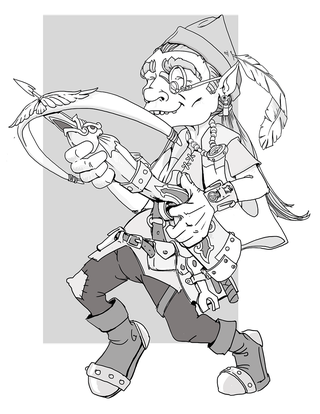
In the Dungeons & Dragons fantasy role-playing game, gnomes are one of the core races available for play as player characters. Some speculate that they are closely related to dwarves; however, gnomes are smaller and more tolerant of other races, nature, and magic. Depending on the setting and subrace, they are often skilled with illusion magic or engineering. Gnomes are small humanoids, standing 3–3.5 feet (91–107 cm) tall.










